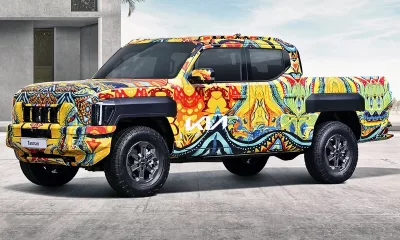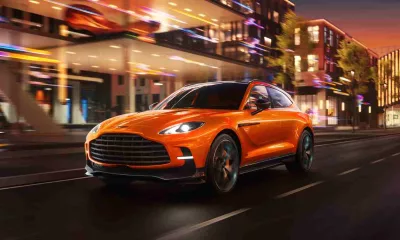
They’re for crossing continents swiftly and in style. Here are 10 legendary grand tourers from the past, in no particular order…
1. Aston Martin DB5

Penned by the Italian coachbuilder Carrozzeria Touring Superleggera, the DB5 is best remembered as the personal wheels of Mi6 agent, James Bond. Bursting onto the silver screen in 1964’s Goldfinger, the DB5 became an instant hit. While production models didn’t come equipped with the ejector seat or machine guns that 007’s example had, it shared the same elegant styling and fabulous 4,0-litre straight-six. Available from 1963, the British GT car produced 210 kW, allowing it to reach 100 km/h in 8,0 seconds. A year later, the DB5 Vantage was introduced. Various performance upgrades allowed for an output of 242 kW, providing superior pulling power. While the DB5 was certainly a sporting vehicle, the iconic Aston featured twin fuel tanks, a full leather-trimmed interior and luxurious wool carpeting. Just over 1 000 examples were produced between 1963 and 1965, before being replaced by the equally gorgeous DB6.
2. Maserati Ghibli

Named after the hot and dry wind that blows through Northern Africa, the Ghibli had dramatic, exotic styling to match its equally exotic name. Designed by Giorgetto Giugiaro while he was still working for Ghia, the Italian fastback first went on sale in 1967. Two V8 powertrains were available; a 4,7-litre V8 with 228 kW and a 4,9-litre V8 “SS” model churning out 246 kW. At the time, the Ghibli SS was Maserati’s fastest road car, capable of reaching 280 km/h. While a five-speed manual transmission was standard, buyers could opt for the three-speed automatic at an extra cost. A convertible option called the Spyder was made available in 1967 and remains a rare sight, with just 125 examples produced. Replaced by the Khamsin and Bora models, the Ghibli name loves on, now as an executive sedan.
3. Ferrari 365 GTB/4 Daytona

Often referred to as one of the greatest Ferraris of all time, the beautiful, V12-powered Daytona cemented the Italian firm’s reputation as the maker of fast, sophisticated grand tourers with the spirit of a supercar. Unveiled at the 1968 Paris Auto Salon, the 365 GTB came equipped with a 4,4-litre Tipo 251 12-pot, producing 259 kW and 431 N.m of torque. This made for impressive performance. Zero to 100 km/h was completed within 5,4 seconds, with the Daytona running out of steam at 280 km/h. A five-speed manual gearbox was the only available transmission. While never raced by Ferrari itself, the Daytona was popular with private racers, who entered the Italian GT cars into events such as the Le Mans 24-hour endurance race. Rather interestingly, while the Pininfarina-designed 365 GTB is commonly known as the Daytona, Ferrari itself says it is an unofficial name.
4. Porsche 928

Originally, the 928 was to replace the 911 range in Porsche’s line-up, as a more grown-up and refined sportscar. Due to many factors, one being the 1973 oil crisis, sales of the 911 were on a decline. Porsche executives thought it would be best to create a more complete car that would offer the performance that the firm had become synonymous with, along with the luxury that Mercedes-Benz and BMW were offering. After being previewed at the Geneva Motor Show, the 928 went on sale in 1978. Despite being praised for its futuristic styling, comfortable cabin and impressive performance, the 928 alienated traditional Porsche customers, who disliked the front-engined layout and hefty price tag. Despite this, the new boy from Stuttgart managed to win the 1978 European Car of the Year award, beating cheaper, more conventional vehicles. Early models were available with a 4,5-litre V8, with either an automatic or manual gearbox on offer. By 1995, the 928 had morphed into a substantially more spohisticated GT car, offering an exceptionally luxurious interior and a 257 kW 5,4-litre V8. Porsche never replaced the 928, although many consider the Panamera to be its spiritual successor.
5. Mercedes-Benz S-Class Coupé (C126)

Based on the W126 S-Class sedan, the C126 SEC combined the luxurious innards of the saloon and the striking good looks of the Bruno Sacco-designed exterior. Introduced in 1981, the SEC was available only with a V8, of which there were various options. Early models available were a 380 and a 500, producing power outputs of 150 kW and 185 kW, respectively. The year 1985 saw a facelift and a power increase, with the original models being supplanted by the 420 and 560. The 560SEC, powered by a 5,6-litre V8 produced 220 kW and 455 N.m of torque, was the most powerful non-AMG version available, capable of hitting 100 km/h in 6,9 seconds. Due to its pillarless design, the seatbelt mounting points were sited further back than usual. Mercedes unveiled the world’s first automatic seatbelt presenter, which would hand the driver and passenger their seatbelts once the doors were shut. Today, this is standard on many high-end coupés. Among many other innovations, the C126 (along with its sedan sibling) introduced traction control to the motoring industry, standard on European models from 1989.
6. BMW 8 Series (E31)

With such beautiful styling, the original 8 Series had those with deep pockets putting their names down in the hopes of getting their hands on one. After being unveiled at the 1989 Frankfurt Motor Show, the E31 had racked up more than 5 000 sales orders. The first model to hit the showroom floor was the 5,4-litre V12 850i, borrowing its heart from the similarly powered 750iL sedan. Shortly afterwards, the cheaper V8-engined 840i became available, with 210 kW. The styling was to be a modern tribute to the M1 of the 1970s, the long bonnet and pop-up headlamps being the tell-tale signs. While there was intention, a combination of rising oil prices and a recession killed off the idea of an M8. As a consolation, the 850CSi was introduced in 1997. The enlarged 5,6-litre V12 made 280 kW and 550 N.m of torque, rocketing the heavy two-door to 100 km/h in just 5,9 seconds. Sadly, poor sales and stiff competition from Mercedes-Benz and Jaguar killed off the 8 series, with production of the beautiful Beemer ending in 1999. Now, of course, the badge is back.
7. Ferrari 456 GT

Replacing the rather disappointing 412, the 456 GT had plenty of weight on its slender shoulders. A 325 kW 5,5-litre V12 sat at the front, sending its power to the rear wheels via a slick-shifting six-speed manual or a more relaxed four-speed automatic. Whichever transmission the original owner chose, they were still in possession of a luxurious and comfortable Ferrari capable of 309 km/h. More importantly, the 456 was the first Ferrari GT that could match the usability levels of its German and British rivals. The year 1998 saw the arrival of the 456 M, a facelifted and improved version. While the engine was unchanged, minor interior trim improvements made the Maranello GT more luxurious and refined. Production ceased in 2003, making this the last Ferrari ever to be sold with pop-up headlamps.
8. Aston Martin DB9

Replacing the equally beautiful but ageing and cramped DB7, the DB9 first went on sale in 2004. To reduce spending, the DB9 shared multiple components with other Ford-owned vehicles. Various interior bits and pieces, including the satelite navigation, were borrowed from Volvo. Despite this, the minimalist interior design still managed to evoke a feeling of absolute luxury, with hand-stitched leather and the finest wood trim covering virtually every inch of the cabin. However, Aston Martins are equal parts luxury and performance, and the DB9 was no different. Under the swooping bonnet sits a 5,9-litre V12 producing 335 kW and 570 N.m of torque. The year 2009 saw a facelift and power increase, with the final update coming in 2013. Now, 380 kW and 620 N.m of torque propelled the big Aston to 100 km/h in 4,5 seconds. Over its long production run, the DB9 and its Volante sibling enjoyed great popularity with fans of the Gaydon-based brand.
9. Bentley Continental GT

Widely regarded as the car that saved Bentley, the Continental GT is also the car that introduced an equally wealthy but younger clientele to the traditional British brand. When introduced in 2003, the four-wheel-drive GT car became an instant must-have for the elite, with everyone from Paris Hilton to Arnold Schwarzenegger paying a hefty price to join the exclusive club. Powered by the same 6,0-litre W12 found in the Volkswagen Phaeton, Bentley added a brace of turbochargers for good measure. Producing 412 kW, the big Bentley was capable of hitting 100 km/h in just 4,8 seconds before going on to a truly impressive top speed of 318 km/h. However, this wasn’t what the Bentley was about. Available from the factory with a level of personalisation never before seen, the Continental GT allowed customers to individualise their cars to the smallest details. Now in its second generation, the classy Brit is still popular with wealthy socialites and Bentley aficionados.
10. Ferrari FF

Replacing the controversially styled 612 Scaglietti, the equally divisive FF was introduced at the 2011 Geneva Motor Show. While the FF is a grand tourer at heart, the V12-powered car is actually a shooting brake. The 6,3-litre V12 produces 485 kW and 683 N.m of torque. This was enough power for Ferrari to proclaim the FF the world’s fastest four-seater (at the time), with a top speed of 335 km/h and a 0-100 km/h time of just 3,7 seconds. The power is fed to all four wheels via a seven-speed dual-clutch transmission. The FF has a wonderfully luxurious interior that is as practical as it is stylish. Folding rear seats add an element of flexibility to this focused grand tourer, ofering an impressive amount of utility space for golf clubs or even skis.




